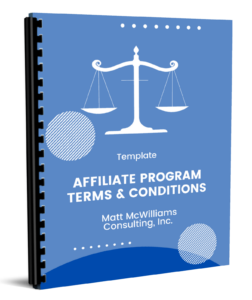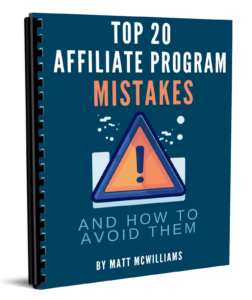Today, we’re exploring the darker side of affiliate marketing—fraud, rule-breaking, and shady activities. While it’s rare, affiliate fraud can be a costly problem. In this episode, I’ll guide you on how to identify affiliate fraud, prove it’s happening, and take steps to stop it.
Click Here for The Written Transcript of This Episode
Looking for some good affiliate programs to promote? Check out our recommended affiliate programs here!
Links Mentioned in this Episode
The 3 Secrets of Success Affiliate Programs
This Affiliate Program Just Made a Fatal Mistake: Here’s What They Should Have Done Instead
Text me at 260-217-4619
Don’t Miss An Episode – Subscribe Below
Previous Episodes of The Affiliate Guy
How to Solve the 15 Biggest Challenges for All Affiliate Programs
What the Latest Research Says About Affiliate Bonus Packages
How to Give Your Affiliates What They Need to Succeed
How to Build an Army of Loyal Affiliates
Got a Low-Priced Product? Here’s How to Run an Affiliate Program
How Top Affiliates are Closing Sales in 2024
How to Identify and Stop Affiliate Fraud
Today we’re taking a trip to the dark side of affiliate marketing, talking about fraud, rule breaking and nefarious activity. It’s a rare but costly aspect of running an affiliate program. And today I’ll show you how to spot the fraud, how to prove it, and what to do about it. So this is a topic I’ve never covered before, 502 podcast episodes, never covered it.
Fraud rule breaking. You know, when affiliates intentionally or sometimes unintentionally, and we’ll talk about that, do something that they shouldn’t be doing. And this is not common, but when it happens, it could be a disaster. Like it can cost a lot of money.
Again, to be totally clear, this is not to scare you away. If you don’t have an affiliate program, this is not like the don’t start an affiliate program. This is very uncommon, but when it happens it’s bad. So you have to be diligent and it requires very little effort.
And I’m going to share more about that shortly. I’m going to share what to look for. What are the indicators? How do you even know that there is some potential fraud going on? How do you actually discover it? How do you root it out? What are the causes? You know, how to prove it and what to do about it.
So first, what do you look for? You know, you have to be on the lookout for fraud depending upon the size of your program. I’m going to give you a rough idea here. For roughly every $100,000 in sales, this is annual sales.
Now, if it’s a launch, you know, this would be roughly $100,000 in sales. For every $100,000 in sales, you’re probably going to spend about five minutes. So yeah, that means if you’ve got a million dollars in sales, you might spend 50 minutes in a week. It begins to kind of peter off around the half million dollar mark.
So it’s about five minutes per 100,000 up to about a half a million. Then it gradually goes up from there. If you’re doing a hundred million dollar a year affiliate program, does that mean you’re going to be spending, you know, 30 hours? Of course not.
I didn’t do the math on that, by the way. So I don’t know what it is, but I want you to commit to spending at least ten minutes a week, you know, for every $200,000 or so, up to about a half million, and then grow from there. And again, these are rough estimates, but be willing to spend a little bit of time. For most of our clients, we spend about a half hour a week, maybe upwards of an hour.
Now, what I’m about to share with you in this what to look for section, these are indicators. These are not necessarily cause for immediate removal. So when I say, for instance, number one, their conversion rate is too high, all right, that doesn’t mean kick them out. Oh, their conversion rate is high.
No, that means that’s the flag that makes you go, huh? Maybe we should look into this. So, number one thing to look for conversion rates that are too high, clicks to leads. So let’s just say that overall, you’ve had 50,000 clicks and 30,000 leads, a 60% conversion rate.
This person sent 500 clicks and they have 496 leads. That’s a red flag. That could be an issue. We need to look into that. The opposite is true. They’re way too low. Clicks to leads. Again, using that example, they have 500 clicks and two leads. That’s kind of weird. We should look into that. Their conversion rates are too high. Leads to sales.
So, on average, let’s say you have 50,000 leads, and so far you have 500 sales, a 1%, you know, close rate, and your top affiliates are all averaging between a half percent and 3%. But this person has 400. Well, that’d be a weird number. They have 200 leads and 70 sales.
Want to learn how to make passive affiliate income from product review posts? Get my free guide on how to write a review post that ranks and converts and learn how we bring in more than $10,000 every single month in passive affiliate income! Get it here!
Again, that does not necessarily mean they’re doing something nefarious. It could be that they have some sort of amazing thing going on with their small number of people. Maybe they only invited their mastermind or their buyers. The only people that they even invited are people who paid them $25,000 and you’re selling $1,000 product and they’re going one on one with them.
That could be, but it’s a flag to look into it. So those are the four things related to conversion rates. The fifth one is they have a flood of clicks followed by droughts. You know, my friend Jeanine Crooks at Sharesale said on one program, and I’m quoting here, on one program, a certain affiliate seemed to be consistently performing at a small but steady level.
However, when she reviewed the daily timing of his activity, it turned out that he was hand entering the leads into our program and our competitors programs as well. To keep his conversion rate realistic, he generated clicks during his coffee breaks while working his day job. So in other words, they send 1000 clicks on one day and then none the next day. Or between the hours of one, and 330 they sent 455 clicks.
And then the rest of the day they sent none. Natural things would tend to show filtering of clicks over time. They might send 400 in an hour and then only 300 the next hour and only 125 the next hour because it’s filtering off. Now this again is not a reason to kick somebody out.
Why? Because it might have been that they were running ads and their ads account got shut down, not because they were doing anything wrong, but it’s a reason to look into it more. Another one is if someone comes out of nowhere and they’re a top affiliate and you have no idea who the heck they are, they’ve not been on the leads leaderboard. All of a sudden they’re on the sales leaderboard way up there.
And like, who the heck is this person? The 7th thing to look for is a high refund rate. You know, if your average refund rate is 5%, anything north of 15, I would be investigating deeply. Obviously, if you ever get a complaint of credit card fraud.
Now, if it’s a known great affiliate who’s done hundreds or thousands of sales, and they have one complaint of credit card fraud, it probably wasn’t them. It was probably somebody who bought and just happened to buy through their affiliate link, I wouldn’t worry about that. But this is a new affiliate. They have nine sales ever, and one of them complained of credit card fraud.
I would investigate the other eight and we’ll talk about what to do on that. And then last is complaints of spam. You know, you’ve got an email forwarded to your service team and it’s spam, and you trace it back to this affiliate. I’ve seen that happen again in and of itself.
Not necessarily a kick immediately out, but it’s investigate further. Okay, it’s investigate further. So maybe don’t think of any of these as red flags, but yellow flags, red flags, you’re gone. Now, these could be all be signs of common frauds.
I’m gonna share a couple of different types of fraud with you. The first is spyware. You know, they have somebody download some spyware, some pop ups, some other adware that inserts it, like, and the backend secretly inserts this code into their computer and it inflates their traffic. They might actually be legitimate customers, but that’s fraudulent activity.
We don’t allow spyware, adware, any of that type of stuff in any of our affiliate programs. So that’s breaking the rules. The second is cookie stuffing. You know, this is where they literally insert the cookie, the affiliate like affiliate tracking on the person’s computer.
So whether the user clicked on the affiliate link or not, it’s going to credit that affiliate domain. Squatting is another one. These look official. So mattmcwilliams.com and they get Mattmcwilliam.com. We have noproductnoproblem.com for our affiliate training, and they get noproductnoproblem.com looks official. And when they go to no product, no problem, it just, or no product, no problem.
They have one little typo and it redirects them, snags the referral. IP spoofing. This is something where they create fake IP addresses to hide their identity. And then the affiliates are literally clicking on their own links to artificially inflate their numbers.
That’s a big bad one. Iframes. Using iframes, basically, it’s kind of like cookie stuffing. Maybe they write a review post and they put an iframe on there that automatically triggers their affiliate link.
And so again, these are all things they could be doing and you don’t know what they’re doing. That’s not the point. The point is they’re doing something postbacs. This is where the fraudulent affiliate, they obtain a transaction id and they have the address, and then they attempt to bypass the actual, you know, bypass the actual, like a real affiliate, and they claim commissions for conversions that never actually happened. It’s really like some deep stuff. Never seen it happen. It just can happen. Fake discount codes.
So somebody goes to Google and they type in, you know, a discount code for your product, and then it’s like, yeah, click here to retrieve this discount code. And it never actually happens. Maybe they don’t even offer discount codes, but now it’s cookied them because they clicked that link. And so when they go back and say, oh, screw it, I’m not even going to bother to try to find a discount code, they just go back to your website. Boom.
Ready to turn your passions into a profitable business? Check out my new book here!
It’s credited to them, though, because they were the last click. And then if you have paper, call. This is a creative one. I read from Liza Schubert, she’s with Astoria company, said affiliates who post fake job opportunities on Craiglist. They’ll ask a potential job seeker to quote, call and pretend to be a real customer. Stay on the phone for at least three minutes.
The fraudulent publisher says this call is part of the interview process. And then if the job seeker does a good job, they will be called in for an interview, which never happens, of course. It’s just a way of simulating traffic because paper call is typically based on the length of time. Now, I would never do three minutes anyway.
I would do like, you know, depends on how long it takes to process an order. But you’re paying for the phone calls, so. Well, they’re on the phone call for, you know, seven minutes. And there you go.
So those are all reasons why. Now, going back to what we talked about at the beginning, I’m going to give you some reasons for removal. All right. These are absolutely like red flags.
You are out if they break the explicit rules. And it’s like a blatant, egregious rule break. If they break the law, if they make false claims, if they’re doing trademark bidding, if it’s not allowed. One of the ways, by the way, if you don’t know what trademark bidding is, where they bid on your name.
Now, here’s the thing. If they know that the affiliate manager lives in Fort Wayne, Indiana, like I do, guess what they’ll do? They will say, don’t run ads in that area. Don’t run, they won’t run ads from Illinois, Michigan, Indiana or Ohio.
To avoid me catching them. I just go to Google and change my location, and I change it to all kinds of different places so I can go look up the trademarked bidding and see if anybody’s bidding on our keywords. And if they are, especially if it doesn’t show up where I’m at. And then it does show up when I change my location.
They know they’re breaking the rules, and I will kick them out in a heartbeat. I will not yellow flag them. I will not reach out to them. I will kick them out, anything like that.
You know, if they’re using scammy tactics, if they’re literally, you know, okay, I search from, you know, the product, and it says it’s such and such a scam. We don’t allow that. You’re out. You know what you were doing, you’re out.
So from there, you got to dig in. All right, so we have some yellow flags, right? We’re seeing some abnormal activity, some conversion rates. Too low. Too high. There’s some weird patterns to the clicks. There’s a little bit of higher refund rate. There’s one complaint about credit card fraud.
What do we do now? We want to dig in and think about some things. So number one, are they in contact with you? You know, scammers don’t typically, fraudsters don’t typically reach out to the affiliate manager very much. They’re usually not in contact. They like to hide. So that’s a consideration. It’s not the end all be all, but it’s a consideration.
Are they always the last click but never the first? So if they have 50 sales and every single one of them had another affiliate assigned to them originally, or 40 of them did, maybe the other ten had no affiliate. They’re always the last click but none of their sales, they’re ever the first. Well, we’re talking about cookie stuffing.
We’re talking about possible iframe. There’s no way that happens, not on that many sales. So I would remove them. In that case, is their sales page visit duration considerably shorter than normal or longer than normal?
You know, okay, your average sales page visit per order is 14 minutes. There’s just three on 32 orders. There’s no way. Or it’s an hour and 15 minutes. There’s no way. That’s just not possible. Look at the length from the click to the activity. Is it way too short or way too long?
Is the IP address the same for multiple purchases? Maybe there’s, maybe they have 50 orders and ten ips. There’s no way that happened. What’s the open rate on their emails? If they sent, somebody sent 1000 leads they have a 0% open rate or they have 100% open rate. What’s the bounce rate? Are a lot of their emails bouncing? These are signs of fraud.
What’s the show up rate for their leads to workshops, what’s the click through rate? So, well they sent 1000 leads and none other people showed up for the webinar, for the workshop, for the live training? Well, the normal show up rates, 27%.
So that’s an issue. Are all of their buyers coming from one route or route? If you want to say route, no, root route, don’t really know. In other words, if you’ve got a big launch and you’ve got a workshop and you’ve got a webinar, got a live stream, you got a q and a live, you got a sales page and all their sales are from the sales page, that’s a possible sign.
Like, okay, there’s no way none of their people bought on the live stream. If they have enough leads, there’s no way none other people bought on the webinar. We want to look at those things. We want to look at a patterns to their lead signups like, okay, are their email addresses similar?
This was probably 1213 years ago. And every single lead that this person sent out of hundreds and hundreds was first initial, last name@gmail.com, There’s no way that’s the case. So that’s not possible. Every single one of them was. Their name was Thomas Jones and it was tjonesmail. It was like tjones followed by a number. That’s what it was. Oh, Ambersmith Asmith 140. Is it that way for their purchases?
Is there a pattern to their names? Do they have, let’s say they have 40 sales, and normally all your sales, 40% of buyers upgrade to a vip version. None of theirs do. All of theirs do.
That’s weird. Is there click to their country different? So their click is from, you know, Spain, but their purchases in Canada, that’s weird. All their clicks come from the same country, but their purchases are all over the world. That’s fraud. Is their shipping address different from their card address? Is that uncommon? No.
Is it common for 15 of 15 sales to have a different shipping address from the card address? No, that’s just not possible. It’s just not possible. So you dig in, you now you’ve red flagged things, right?
Or it’s like a deep yellow and you’ve, like, you’ve proven there’s something there and then you got to prove it. So if you’ve checked search results, if we’re talking a violation of trademark bidding, check the search results, take screenshots. That’s it. You violate our trademark bidding, I have the right to kick you out.
You know, we talked about the time between clicks, okay? There’s always a click at 952 and then another one at 953. It’s always 1 minute later. Every other affiliate has sporadic patterns. Seven minutes, two minutes, 1 minute, twelve minutes, an hour and 14 minutes. Theirs is always 1 minute. That’s probably a script. And I’ve seen that happen.
I’ve seen it happen where they were able to get into. They hacked the page and they put their script on and it ran at the exact same interval. So then check your page for scripts. Make sure you get those removed right.
And then ultimately at the end, contact buyers, see if they actually bought, see if they intended to actually buy from this affiliate. This solves the problem. And they say, oh, I heard about you from so and so, and that’s not the affiliate that actually got the credit. Eight people reply back and all of them say a different affiliate.
That’s not normal. They’re doing something. You’ve proven it beyond a shadow of a doubt. So then what do you do about it? What do you do about it? First of all, make sure your affiliate terms are airtight. Are the things that you call fraud actually listed as fraud? Are your rules clear?
Okay. You can’t kick an affiliate out for bidding on your trademark terms if you don’t tell them not to. That’s not inherent. Some affiliate programs actually allow it. Some affiliate programs advocate it. So there’s nothing wrong with it provided that it’s actually allowed. So are your rules clear? Secondly, when do you warn and when do you remove? We warn when they break a rule. Like, you know. Yeah, we say, don’t do trademark bidding. Well, here’s the thing.
If the term is okay, of course, you know, company, I used to work for legacy learning systems learn and master guitar. And when I go search for learn and master guitar and they bid on learn guitar, that’s not a trademark violation. So we tell them, we say, hey, make sure you do a negative keyword so you don’t show up. It doesn’t look like you’re bidding on learn and master guitar.
That’s it. Just don’t bid on this exact phrase. And we just teach them. We reach out and we say, hey, don’t do it. If it’s clear, they’re running an iframe, they’re out. They’re cookie stuffing. They’re out. They’re doing anything like domain squatting or spyware, adware, things, fake discount codes.
They are bye bye. Like, we are kicking them out. Some of the things, it’s a warning. It’s just a warning. Hey, you know, don’t do that. That’s against the rules. Or maybe we need to update our rules. Oh, used a picture that we said you shouldn’t use.
Hey, make sure you don’t use it right. And then the big thing is act. You’ve got to take action fast. Take action fast. If you know beyond a shadow of a doubt there’s a problem, take action to remedy it.
To get started with affiliate marketing the right way, download my free quickstart guide to affiliate marketing. Grab your copy here!
If it’s a script on your page, get the script off there right away. You know, there’s nothing wrong with that. It turns out maybe it’s not that affiliate. Like, that’s not even what’s doing.
It’s not even this thing. But you just, there’s a weird script, so get it off there. If they’re doing anything nefarious, you got to kick them out right away and let them know. Because the other thing is you don’t want to just shut down their account and not tell them because then they might still have the ads running or the pop ups running for 36 hours and people are still getting, you know, they’re, maybe they’re going to an error page or they’re still running the ads and it
could come back to bite you and document everything. Don’t call them. Either text them or email them so you can document. So if they come back and say, you didn’t pay me my commissions, you can go, yeah, because you’re fraud.
We got proof right here. And in case anything ever comes back to bite you, this is very rare, but like, somebody files a complaint against you for running adware when you’re not the one doing it. So take action fast. Make sure you contact them.
Tell them to remove their ads, to shut down their stuff. You’re not going to pay them. And make sure they know that. So again, this is not a huge issue, but it’s one that you have to be on top of.
So now you know how to find it, how to, how to get, like, what are the triggers? What are the yellow flags? Right? You know what to be looking for, you know how to dig in and you know what to do about it.
If you got questions about this or anything else, text me anytime at 260-217-4619 I’ve got plenty more stories to share on affiliate fraud. I’m happy to share with you. So feel free to text me anytime at 260-217-4619 if you got any questions about fraud or anything else and make sure you hit subscribe so you don’t miss the next episode. I’ve got some creative ways to triple your affiliate commissions. You don’t want to miss it. I’ll see you then.
Questions?
Text me anytime at (260) 217-4619.
Or…check out some of my free reports to help you get on the right track:
 |
 |
 |
 |
 |
 |
 |
 |
 |












